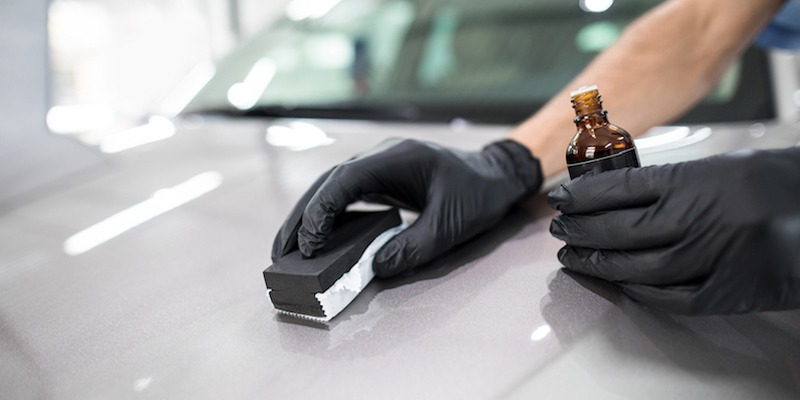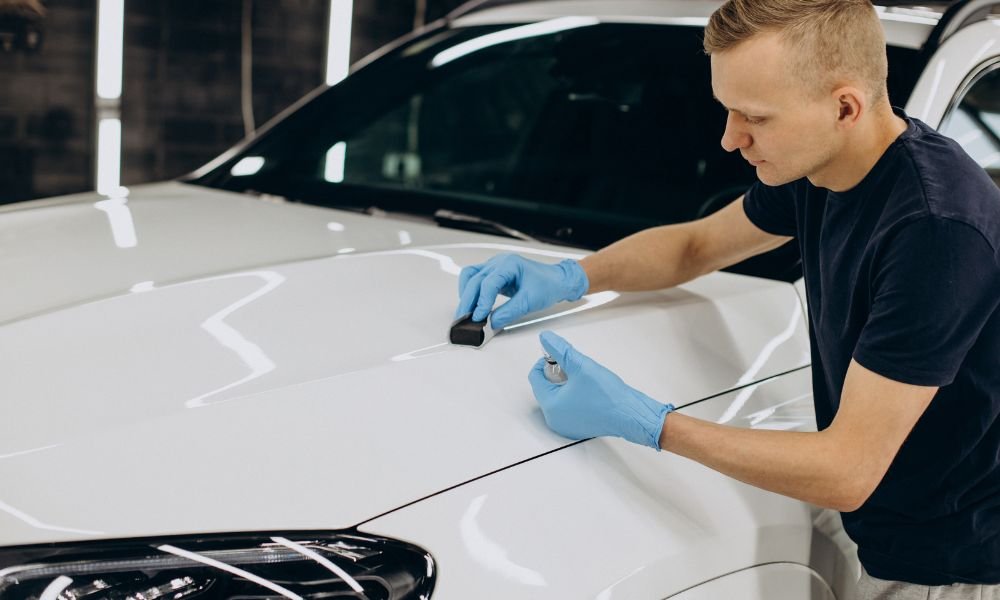Specialist Tips for DIY Ceramic Coating Application at Home
Wiki Article
The Relevance of Ceramic Coating: Safeguarding Your Vehicle's Exterior With Accuracy
In an era where preserving the practical and visual integrity of your automobile is paramount, ceramic finishing arises as a pivotal service. With its one-of-a-kind bonding properties, ceramic covering uses a degree of defense that much surpasses standard waxing approaches.Advantages of Ceramic Coating
When it comes to preserving an automobile's aesthetic appeal, ceramic coating supplies substantial benefits. By creating a semi-permanent bond with the automobile's paint, ceramic finishings efficiently prevent oxidation and fading, ensuring that the auto preserves a shiny, showroom-like surface for an extended duration.Along with its protective qualities, ceramic coating supplies exceptional hydrophobic properties, creating water and other liquids to grain off effortlessly. This function simplifies the cleansing process, as dirt and debris are much less likely to stick to the surface, lowering the regularity and effort needed for upkeep. Moreover, the covering's resistance to chemical discolorations from acidic contaminants like bird droppings and tree sap is an additional noteworthy advantage, minimizing possible paint damage.
Ceramic coverings additionally enhance scratch resistance, giving a layer that can absorb minor abrasions and swirl marks. This feature is particularly valuable in maintaining an immaculate surface area, minimizing the possibility of noticeable blemishes and maintaining the integrity of the vehicle's paintwork over time.

Just How Ceramic Coating Functions
Comprehending the technicians behind ceramic layer reveals its efficacy as a safety solution for cars. Ceramic finishings are basically fluid polymer applications that chemically bond with a vehicle's manufacturing facility paint, creating a protective layer. This layer functions as a barrier against environmental contaminants such as ultraviolet, crud, and dust rays, which can weaken a vehicle's exterior over time. The vital part in ceramic finishing is silicon dioxide (SiO2), which originates from quartz crystals and is known for its exceptional solidity and sturdiness.Application of ceramic finish includes a precise procedure. The lorry's surface area need to be thoroughly cleansed and decontaminated to ensure ideal adhesion. Once applied, the liquid polymer creates a semi-permanent bond with the paint, solidifying into a clear, resilient shield. This guard improves the vehicle's gloss and hydrophobic buildings, assisting in simpler cleansing by creating water and pollutants to bead and slide off effortlessly.
Furthermore, the layer's molecular structure offers resistance to minor scrapes and chemical stains. Unlike waxes or sealants that rest on top of the paint, ceramic coatings integrate with the surface, supplying long-lasting protection. This assimilation is fundamental to its efficiency, making certain the car's coating continues to be pristine for many years.
Contrasting Ceramic Coating to Alternatives
In the world of automotive protection, ceramic covering stands as a powerful choice when compared to standard options such as waxes and sealers. While waxes use a short-lived lustrous finish, generally lasting just a couple of weeks to months, ceramic coverings supply a longer-lasting solution, usually enduring for several years. This resilience is credited to the chemical bonding that occurs when ceramic layers are used, developing a solid layer that is resistant to ecological threats.
Contrastingly, sealers, although even more resistant than waxes, still fall short of the robust protection provided by ceramic finishings. Sealants can normally last for as much as a year, offering a synthetic guard against certain components. Nonetheless, they do not have the remarkable hydrophobic properties and UV defense that ceramic finishes deliver.
In addition, ceramic finishings offer enhanced scrape resistance, which neither waxes nor sealers can effectively match (ceramic coating). This is specifically helpful in maintaining a vehicle's immaculate appearance. In addition, ceramic finishings streamline maintenance initiatives by reducing the adherence of dust and grime, consequently helping with less complicated cleaning. In summary, while traditional waxes and sealers offer fundamental defense, ceramic finishings offer an extensive, lasting service that substantially preserves the car and boosts's exterior finish.
Application Process Described
Using ceramic finish to a lorry calls for a precise process to guarantee ideal results and sturdiness. The preliminary action includes extensively cleaning the vehicle's surface to remove dirt, grease, and previous waxes. This is important for making certain the layer sticks appropriately. A pH-neutral hair shampoo and a clay bar treatment are typically used to attain an immaculate surface. As soon as cleansed, the vehicle is dried out and polished to eliminate any blemishes, as any type of existing swirls or scratches can become more noticable after the coating is applied.Adhering to surface preparation, the application of the ceramic finish starts. Utilizing an applicator pad, the ceramic layer is used in tiny areas to guarantee also protection.
After application, the finish needs a particular curing period, throughout which the car needs to be safeguarded from water and pollutants. This curing procedure can vary relying on the product but generally ranges from 24 to 48 hours. Ultimately, this in-depth process is essential in accomplishing a resistant and shiny surface.
Upkeep Tips for Long Life
To maintain the long life of a ceramic finishing, adherence to a regimented upkeep routine is essential. Routine washing is paramount; utilize a pH-neutral automobile shampoo and soft microfiber gloves to stay clear of abrasions. Prevent automatic cars and truck cleans, as site here their extreme brushes can jeopardize the finish's honesty. Rather, choose for a hand laundry to ensure complete yet gentle cleansing.Post-wash, drying the vehicle with a tidy microfiber towel avoids water spots that might deteriorate the finishing over time. Additionally, use a ceramic finish booster every few months. useful source These boosters enhance the hydrophobic residential properties and improve the coating's protective abilities, guaranteeing it stays efficient versus impurities.
Keep in mind that parking areas play a vital duty in maintenance. ceramic coating. Whenever feasible, park in shaded locations to reduce UV exposure, which can slowly compromise the layer. For lasting storage, consider utilizing a vehicle cover for included security versus environmental components
Conclusion
To conclude, ceramic finishing acts as a crucial safety layer for vehicle exteriors, supplying lasting protection versus ecological elements such as uv, gunk, and dust rays. By forming a semi-permanent bond with the paint, it enhances visual charm while protecting the automobile's value. Its hydrophobic residential or commercial properties promote easier maintenance, identifying it from different protective techniques. Comprehending the application procedure and sticking to upkeep suggestions are necessary for maximizing the longevity and efficiency of ceramic layer.When it comes to preserving a vehicle's visual appeal, ceramic coating provides considerable benefits. By creating a semi-permanent bond with the car's paint, ceramic finishes effectively prevent oxidation and fading, guaranteeing that the automobile maintains a shiny, showroom-like coating for an extensive period. Ceramic layers Visit Your URL are essentially liquid polymer applications that chemically bond with a cars and truck's manufacturing facility paint, developing a safety layer. In recap, while conventional waxes and sealants supply basic defense, ceramic coatings provide a comprehensive, lasting remedy that significantly improves and protects the automobile's exterior coating.

Report this wiki page